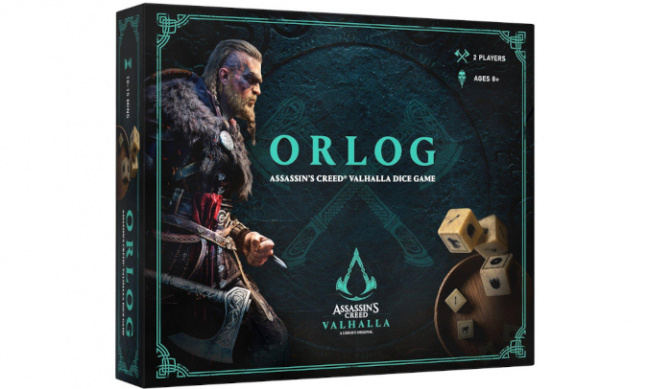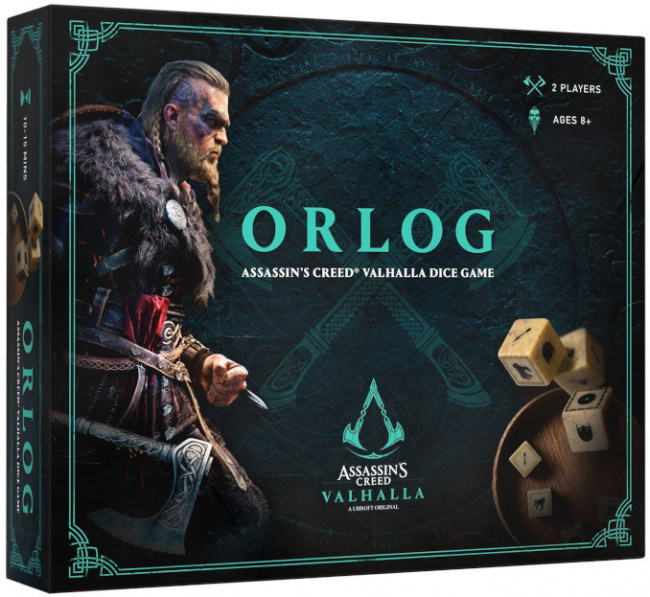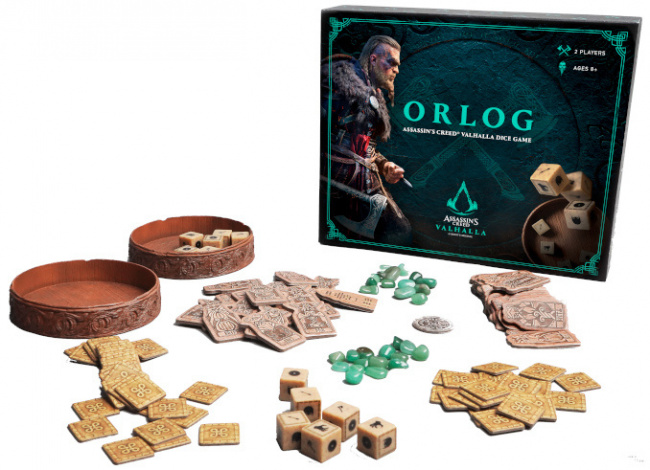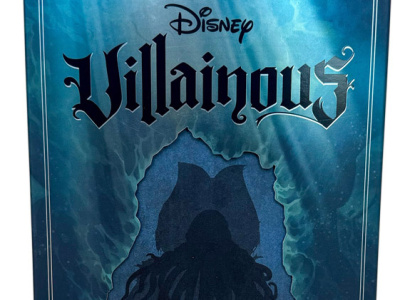Orlog: Assassin's Creed Valhalla Dice Game
Publisher: PureArts Limited
Designer: N/A
Release Date: June 8, 2022
MSRP: $39.99
Number of Players: 2
Playing Time: 10-30 mins.
UPC: 7-13929-40410-0
Age Rating: 8 and up
ICv2 Rating: 3 Stars out of 5
Within the fictional world of Ubisoft’s Assassin’s Creed Valhalla video game there exists a fictional dice game known as Orlog. Popular among that world’s Norsemen and Anglo-Saxons, players can be found in every city, testing their wits and luck against one another. Now, thanks to a partnership between PureArts and Ubisoft, the game of Orlog has become real, and players outside of Assassin’s Creed can try their hand at it as well. But does this game make the jump into reality successfully?
Summary: Each player has six dice with icons for axes, arrows, helmets, shields, and thieving hands, some with gold frames representing the favor of the gods. They both start with 15 polished stones to track their hit points ("HP"), a plastic bowl, and 3 tokens depicting Norse deities. Over a series of rounds, the players use their dice to attack, defend, and invoke their deities, with the goal of reducing their opponent to zero HP.
In each round, players have three turns to roll their dice. After each roll, they choose which dice they will keep and which they will re-roll on their next turn. The symbols they have after their final roll are then used to attack (axe and arrow), defend (helm and shield), gain favor tokens (gold frames) and steal them from their opponent (hands). Each undefended attack reduces the target’s HP by one. Finally, the favor tokens can be spent to power the effects of a chosen God Favor card, and each of the game’s 20 gods offers a unique favor. Once an opponent is reduced to zero HP, they are knocked out and their opponent claims the victory.
Originality: The give and take of the dice rolls within each round is what makes Orlog interesting. Unlike similar dice games, a player does not make all their rolls and re-rolls at once before the next player begins their turn. Instead, they take turns making a single roll or re-roll at a time, with up to three in total per player. This allows them to adjust their strategy "on the fly" as they see which symbols their opponent is keeping or discarding. The favor tokens and God Favors add an additional level of strategy, raising the game above a simple luck-fest and rewarding long-term planning.
Presentation: All of the components are beautiful to look at. The plastic dice bowls are molded with wood-grain and Norse-style artwork effects. The polished HP stones are real stones (Aventurine, perhaps? I’m no geologist…). The God Favor cards are made to look like carved wood, and have a neat little image of the god and their runic name on one side and an effect description on the back. The dice have a textured coloration, and the icons are clear and easy to read. The box is only the size it needs to be to hold everything, and sports a very well-designed plastic tray and lid to hold the components neatly in place.
Quality: Not only are the components nice to look at, they are crafted from good-quality materials as well. The tokens and cards are nice thick cardboard. The bowls are solid, sturdy plastic. The dice are printed rather than molded, which is disappointing, and I found that they make too much noise if you roll them into the bowls. But the bowls proved perfect for storing HP stones, favor tokens, and dice that have been "locked" on my turn. On the downside, I found the type used on everything, from the rules to God Favor cards, way too small to read without a magnifier and bright light. They are simple enough to memorize, but that is a huge obstacle to learning the strategy of the game.
On the subject of the rulebook, I found it to be simply inadequate. The main mechanics are not described in detail. Many of the God Favor effects are open to interpretation (Can I "heal" above my starting HP? What does "Ban 1 die" mean?) because the game terms are not defined. Some God Favors create physical problems: one awards a player extra dice to roll, but there are no extra dice in the box and no explanation of how to handle this mechanic. Fortunately, there are videos online that teach the gameplay well, but I’m old-fashioned enough to still think I should be able to learn a game solely from the rules in the box, and not have to watch an eight-minute video if a quick question comes up during play. I was left feeling that I was expected to have already learned the game by playing Assassin’s Creed, rather than Orlog standing on its own.
Marketability: Assassin’s Creed is a widely popular property, recognizable even by people who are not conversant in video gaming, and pretty much anything Norse has always had a strong appeal to gamers of all ages. The quality of the components seems appropriate for the price tag, which otherwise feels a bit high for a dice game, even one with better-than-average strategic depth and intriguing mechanics.
Overall: Once I managed to overcome the obstacles to learning how to play Orlog and actually dug into it, I was pleasantly surprised by what I found. Looking at the components, I feared that it would be all form without function, which sadly is a common problem for games inspired by video games. The fact that players can modify their actions in real time and the way short-term tactics of dice rolling interact with the long-term strategy of the God Favors gives Orlog a meatiness that I did not expect from a dice game, and it rewards thoughtful play in a very satisfying way.
But it is hard to overlook the game’s shortcomings; from the less-than-thorough rulebook to the virtually unreadable cards, learning and playing Orlog is a lot harder than it should be. I don’t know if fans of Assassin’s Creed will be eager to make the jump into tabletop gaming, and I really feel that they are the target audience here, as the price point is high enough that I fear non-fans might be reluctant to plunk down their hard-won silver for a dice game. And that’s why I’m giving this game 3 out of 5.
Click on Gallery below for full-sized images of the game contents.
- William Niebling

ICv2 Stars: 3 (Out of 5)
Posted by William Niebling on July 1, 2022 @ 4:24 pm CT
MORE GAMES
Featuring the Magical Houses of the Series
July 29, 2025
heo Group unveiled new Harry Potter 4-Pocket Zipfolios.
'Salamence ex & Reshiram ex'
July 29, 2025
The Pokemon Company International will release Salamence ex & Reshiram ex Premium Collection, for Pokemon TCG, into retail.
MORE REVIEWS
ICv2 Stars: 3.5 (out of 5)
July 24, 2025
Check out the review of Disney Villainous: Treacherous Tides, from Ravensburger.
ICv2 Stars: 4 (out of 5)
July 11, 2025
Here's a review of Positano, published by Slugfest Games.





 View Gallery: 4 Images
View Gallery: 4 Images 



